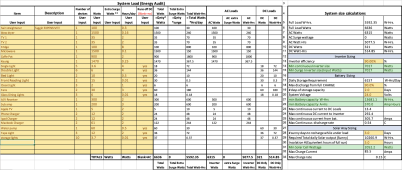Hi everyone,
So I’m really interested in beefing up the electrical on my motorhome. I’ve been doing quite a bit of research, but what I’m discovering is that I don’t know what I don’t know. On top of that, I’ve been a residential/commercial/industrial electrician for 20+ years, but almost no experience with DC, so I know just enough to be dangerous. I know where I want to end up, but was hoping you guys could offer some…course corrections.
•I have (8) EVE LF280K cells on the way. I’ll be assembling (2) 4S batteries with them. (We currently have (2) 101AH lead acid house batteries, and no inverter)
•I plan to purchase a Victron Multiplus II 12/3000 for our 50A motorhome
•I’d like to be able to charge from the stock alternator while driving (existing converter is at least 35A)
-> Renogy 20 DC-DC or Victron?
•I believe I’ll be using a 4S200A JBD BMS on each battery
•I believe I’ll be using a Raspberry Pi 4 with a touch screen instead of a Cerbo GX so that I can use the JBDs and still have communication between all my components and have the GUI
• I believe I should go with the Smart Shunt as it’s considerably more accurate than the BMS
• I plan on installing 1200W of Solar on the roof *next year*, so I’ll only be able to recharge with the onboard generator, shore power, and hopefully alternator.
My plan is to follow the widely available diagrams and I’ll be figuring out proper wire sizes. However, I don’t have the expertise to know for sure that all these components will play nicely, but I believe they will.
Can anyone offer any critiques or see where I might be making poor choices? I’m sure I’ve probably left out some pertinent info, so feel free to tell me what you need to know. Oh, I’m in Alaska, but we won’t be using the motorhome outside of spring, summer, and fall when temps are 40f or better. As far as anticipated loads…small coffee pot a few times a day, A/C isn’t necessary, but I want to make at least 1 unit (120v 20A) an option, charging a couple laptops, iPads, phones, we have two LED TVs and a Yamaha AV receiver with surround sound (600W system I believe), all LED interior lights, double fridge (RV size) microwave, and all the other “normal” RV stuff.
Thanks for any help, comments, suggestions, and critiques!
So I’m really interested in beefing up the electrical on my motorhome. I’ve been doing quite a bit of research, but what I’m discovering is that I don’t know what I don’t know. On top of that, I’ve been a residential/commercial/industrial electrician for 20+ years, but almost no experience with DC, so I know just enough to be dangerous. I know where I want to end up, but was hoping you guys could offer some…course corrections.
•I have (8) EVE LF280K cells on the way. I’ll be assembling (2) 4S batteries with them. (We currently have (2) 101AH lead acid house batteries, and no inverter)
•I plan to purchase a Victron Multiplus II 12/3000 for our 50A motorhome
•I’d like to be able to charge from the stock alternator while driving (existing converter is at least 35A)
-> Renogy 20 DC-DC or Victron?
•I believe I’ll be using a 4S200A JBD BMS on each battery
•I believe I’ll be using a Raspberry Pi 4 with a touch screen instead of a Cerbo GX so that I can use the JBDs and still have communication between all my components and have the GUI
• I believe I should go with the Smart Shunt as it’s considerably more accurate than the BMS
• I plan on installing 1200W of Solar on the roof *next year*, so I’ll only be able to recharge with the onboard generator, shore power, and hopefully alternator.
My plan is to follow the widely available diagrams and I’ll be figuring out proper wire sizes. However, I don’t have the expertise to know for sure that all these components will play nicely, but I believe they will.
Can anyone offer any critiques or see where I might be making poor choices? I’m sure I’ve probably left out some pertinent info, so feel free to tell me what you need to know. Oh, I’m in Alaska, but we won’t be using the motorhome outside of spring, summer, and fall when temps are 40f or better. As far as anticipated loads…small coffee pot a few times a day, A/C isn’t necessary, but I want to make at least 1 unit (120v 20A) an option, charging a couple laptops, iPads, phones, we have two LED TVs and a Yamaha AV receiver with surround sound (600W system I believe), all LED interior lights, double fridge (RV size) microwave, and all the other “normal” RV stuff.
Thanks for any help, comments, suggestions, and critiques!



